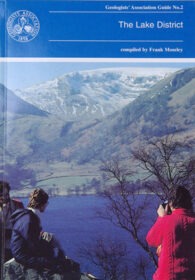Geologists’ Association Guide No 2
Compiled by Frank Moseley

The Lake District is obviously a prime UK holiday hotspot and, each year, thousands of people visit to enjoy the walking and scenery. Equally obvious is the fact that these activities are possible as a direct result of the geological and geomorphological processes of the area.
The Lake District was only the second guide to be produced by the GA. The first edition was printed in the orange paper format of the early guides in 1970. A second edition was produced in 1990, which was reprinted in 1997 (which is where my copy comes from).
Since the first edition was published, a huge amount of new work on the area has been published, a lot of which flows from the revolutionary idea of plate tectonics. As a result, the place of the Lake District in the evolution and destruction of the Iapetus Ocean is now known and many of what were once enigmatic structures of the Skiddaw Slates are now seen in the light of this overarching theory. Similarly, the nature of the Borrowdale “volcano” is much better understood, as are the sequences and events of the upper Ordovician and Silurian sediments.
However, it is acknowledged in the guide that this complex nature of the region means that some selection was inevitable. However, it still contains 25 itineraries written by different experts in their field, the choices of which read like a list of many of the best walks in the Lake District.
The guide is designed to be used with topographical maps and covers:
- A geological road map of the Lake District.
- Mungrisdale and the Caldew Valley.
- The Carrock Fell Igneous Complex.
- The Skiddaw Group of Hope Beck, Hopegill Head and Gasgale Gill.
- The Buttermere Formation (Skiddaw Group) in the Robinson area.
- The Skiddaw Group of Stoneycroft Gill, Causey Pike and Outerside.
- Devok Water and Yoadcastle.
- Upper Eskdale to Scar Lathing and Silverybield Crags.
- Cockley Beck-Grey Friar.
- Hard Knott, Eskdale.
- Harter Fell, Dunnerdale.
- Buckbarrow and Middle Fell, Wasdale.
- Holehouse Gill.
- Ulpha-Kiln Bank Cross.
- Coniston the Levers Water.
- Nab Gill Mine, Eskdale.
- Explosive volcanism and volcanotectonic subsidence at Crinkle Crags.
- Subaerial pyroclastics of Side Pike, Langdale.
- The Tilberthwaite Tuffs fro Langdale to Tilberthwaite.
- The Lower Borrowdale Volcanic Group of Brown Knotts, Borrowdale.
- The Borrowdale Volcanic Group at Seathwaite.
- The upper Borrowdale volcanic and l0wer Windermere Group.
- The Windermere Group (late Ordovician and Silurian of the eastern Lake District), Longsleddale, Stockdale and Brow Gill (Coniston Limestone Formation to Brathay Flat Formation).
- Kentmere.
- The Westphalian and Permian geology of the Whitehaven area.
The book is illustrated by black and white diagrams and sketch maps, which suggests that it may be time for the GA to produce a third edition. Today, there are also many
Other books reviewed on this site about the Lake District (there will be more soon) include:
| Rock Trails, covering: Lakeland, Snowdonia and Peak District |
| Lakeland Rocks |
| Roughton Gill and the Mines of the Caldbeck Fells |
The Lake District, Guide No 2 (2nd edition), by Frank Moseley, The Geologists’ Association, London (1990) (reprinted in 1997), 213 pages (paperback), ISBN: 0900717734


